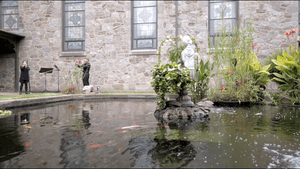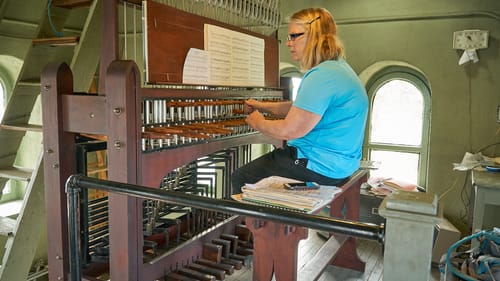Stay in the Loop
BSR publishes on a weekly schedule, with an email newsletter every Wednesday and Thursday morning. There’s no paywall, and subscribing is always free.
Streaming with bells on
Piffaro presents ‘The Bells and Whistles of Utrecht’

We are increasingly adept at substitutions: vinegar in milk for buttermilk, distanced learning, Zoom meetings, virtual concerts. Most of these workarounds work—or we make them work. But occasionally the “ersatz” leads to something new: an ingredient, a skill, or a new way to experience the familiar. That was the welcome surprise of The Bells and Whistles of Utrecht, Piffaro’s buoyant, beautiful season opener, a recording available to stream through November 5.
Ambiance of the Netherlands
In the fall, many ensembles offer special dark “spooky” music. But in this pandemic year, Piffaro gave us a joyful concert full of light and vivacity. We may wish to again be in the room with the music, but here, these wonderful musicians delightedly showed us their new path. The ensemble often introduces musical territory that’s new to many, and this was no exception. Here, they explored the world of blind Dutch 17th-century musician and composer Jan Van Eyck, a bell ringer and virtuoso on two of the world’s most disparate instruments: the massive carillon and the delicate recorder.
To create the ambiance of Van Eyck’s Netherlands, Piffaro played outdoors on the serene grounds of Germantown’s Miraculous Medal Shrine. Its grey stone buildings enclose a courtyard with a soothing fountain and gardens reminiscent of a medieval abbey or the town streets where this music would have been heard. Though the beautiful environment and Piffaro’s supple musicianship made you long to be there, this was an event best experienced via recording.
Musicians on camera
Recorded over two luscious September days, the concert was shot like a film, beautifully captured and edited with pristine, sensitive audio by John Baker and creative, respectful video by Sharon Torello. As filmmakers can do (but often do not), they moved the cameras or lingered on the musicians for just the right amount of time to create striking aural and visual intimacy.
Throughout, it was apparent that the ensemble was fed by both the setting and by one another. Piffaro artists always play with consummate skill and joy in their music, but here, their clear delight in again being together was movingly captured. They played in varied locales throughout the Shrine’s evocative stone walls, wooden doors, fountains, arbors, koi pond, and—most critical for this concert’s music—its magnificent carillon.
Bells and trumpets
A carillon (the world’s heaviest instrument) is a rank of tuned bells. Here there are 47, played (wonderfully) by the Shrine’s resident carilloneur, Janet Tebbel. Tebbel, widely known for her musicianship (heard regularly here and recently at Longwood), plays the instrument’s keyboard by striking its batons with her fists in a sort of musical “tiny house” atop a 125-foot stone pillar, making the carillon a perfect socially distanced instrument.

The film captured Tebbel in her aerie as she executed the music’s challenging runs and trills, tossing melodies back and forth with the band in the courtyard below. A carillon player (then or now) could never hear other musicians; only editing made this musical dialogue possible. And as a bonus, periodically there were stunning aerial drone shots of the grounds and the city.
The concert opened with pealing bells (Tebbel) and the gorgeous six-foot-long Baroque fanfare trumpets (Erik Smaltz and Lisa Malamut). They were soon joined by the rest of this iteration of the band—Joan Kimball, Bob Wiemken, Grant Herreid, and Priscilla Herreid—portraying the “Stadstrompers (city wind players),” the town musicians who would stroll the Dutch streets and play for various occasions.
Better than being there
Piffaro is noted for its programming structure and vivid program notes, here as downloads. They are multi-instrumentalists, switching smoothly and expertly here, as always. The concert’s 30-plus works (some short) featured melting solos, expert duos, and wonderful ensemble pieces like the jaunty Der Fluyten Lusthof, which opens with bagpipes. The pipes, sometimes overwhelming in a small, acoustically live space, were here perfectly balanced, heard as they were in the 17th century: outdoors.
During intermission, Piffaro always invites audiences for a close look at its remarkable early music instrumentarium. But here it was possible to see up close the gleaming brass, fine-wrought insets, swirling wood grain, and elegant fretwork as they played. To the musicians, these are everyday sights, but this was a visual treat for the video audience. This season’s other concerts will also be recorded, and a modestly priced ticket grants access for a week after the performance.
The lovely concert ended as it began, with beautiful drone overheads and the peal of carillon bells. This was a magical musical offering, and at some point, superlatives become superfluous. Bells and Whistles was more than a substitute for being there. Ecstatically played and excellently recorded, it was a joy.
Image description: A photo with a large koi pond in the foreground, with orange and white fish in it. Behind the pond, against the wall of a large stone house, two musicians play long, straight medieval trumpets.
Image description: A photo of carilloneur Janet Tebbel playing the carillon. In a small room with a wooden floor, the carillon is a complicated instrument made of wood and metal parts that stands higher than the musician and is several feet wide. Instead of keys, as an organ would have, it has dozens of small wooden levers called batons. Janet Tebbel has blond hair and wears a light blue shirt.
What, When, Where
The Bells and Whistles of Utrecht. Works by Van Eyck, Praetorius, Sweelinck, Clement non Papa, and others. Ensemble members Joan Kimball, Bob Wiemken, Grant Herreid, Priscilla Herreid, and Erik Schmalz, with guest artists Liza Malamut (trumpet, sackbut) and Janet Tebbel (carillon). Piffaro Renaissance Band. Aired October, 30, 2020, and streaming through November 5. Recorded September 2020 by John Baker and Sharon Torello at Miraculous Medal Shrine and Carillon, Germantown, Philadelphia. piffaro.org.
Sign up for our newsletter
All of the week's new articles, all in one place. Sign up for the free weekly BSR newsletters, and don't miss a conversation.
 Gail Obenreder
Gail Obenreder